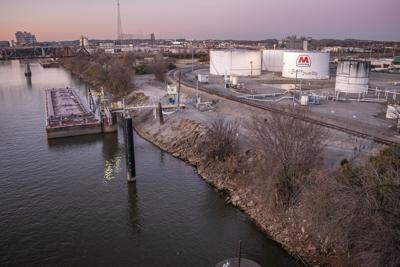Metropolitik is a recurring column featuring the Scene’s analysis of Metro dealings.
Planners and urbanists have fixated on Nashville’s East Bank for decades. While commerce bustled on the Cumberland River’s west side, industrial sprawl made the East Bank hostile to people. A harsh landscape of petroleum terminals, logistics facilities and scrap metal surrounded the Tennessee Titans’ campus, empty except for a few gameday Sundays.
Former Mayor John Cooper pitched the public on a total area revamp — Nashville’s “next great neighborhood” — anchored by a $2.1 billion new stadium heavily subsidized by the city and state. For at least five years, the city has invited residents into the East Bank planning process, a seemingly endless sequence of surveys, documents, designs and “envisioning” for the hundreds of acres between I-24 and Lower Broadway. Additional budgeted infrastructure and planning costs easily top $800 million.
City, Fallon Company enlist NYC-based firm to create outdoor spaces for future development
The Metro Council adopted the site’s major guiding document, “Imagine East Bank,” in October 2022. City officials and Metro’s ample team of planners, which has included a dedicated East Bank team for years, regularly repeated the neighborhood’s commitment to “multimodal” transportation. The vision plan itself, which reads like a manifesto for pedestrians and bicyclists, mentions “multimodal” a whopping 63 times. For years, boosters have pushed the plan as an oasis for non-car mobility and a key nexus between east and west, earning trust and buy-in from the city’s small, growing and active transit community.
But much of that trust and support has evaporated in recent weeks, after the city expressed an apparent design preference for the neighborhood’s central artery, East Bank Boulevard — the design reserves three vehicular lanes in each direction and drops the protected bike lanes or cycle track alternatives advertised by “Imagine East Bank.”
Metro has not made a final decision on East Bank Boulevard. Mayor Freddie O’Connell has avoided expressing a personal preference on the topic. When an April 22 presentation from East Bank Development Authority CEO Ben York scrubbed boulevard bike lanes, the city’s tightly connected network of urbanists and bike advocates realized that institutional alignment had shifted against them. A subsequent public survey mentioned only the six-lane vehicle option. At some point, the urbanists speculated, the all-vehicle option went from a scenario — frequently maligned by some public feedback as a regressive concession to cars that would discourage walking and biking — to the default.
O’Connell announces Metro veterans Ben York, Anna Grider to oversee the complex public-private development
Prompt blowback began from groups like Walk Bike Nashville, the Civic Design Center and the Southern Environmental Law Center. Veronica Foster, the Civic Design Center’s communications manager, skewered the proposal in a blog post.
“Is it the city’s preference?” Foster says to the Scene. “We don’t actually know that. The biggest issue right now is that no one is taking responsibility over the boulevard. There’s a lot of confusion around who makes the final decision on the boulevard design. We’ve been asking that question, and we don’t have the answer.”
At a public meeting in late April, Wesley Smith of Walk Bike Nashville, referring to anticipated pedestrian and cyclist safety concerns, said, “People will die.” In lawyerly fashion, the Southern Environmental Law Center circulated a memo from city survey data that showed overwhelming public opposition to the six-lane plan that the city seemed to favor. In recent weeks, these critical groups have begun referring to the all-car alternative as a “six-lane highway” to emphasize its perceived hostility to pedestrians and cyclists.
In May, York publicly clarified that the decision had not yet been made and all alternatives remained on the table, but damage had been done. Advocates say they’re worried the mayor and others will continue burying the crucial planning choice in city bureaucracy to diffuse any one entity’s responsibility.
Many individuals tell the Scene they feel personally betrayed by O’Connell, a longtime advocate for bikes and public transit with a go-to campaign stump anecdote about how he saved up for a down payment on his house by eschewing car ownership. York and other Metro stakeholders direct feedback to the various community meetings, hearings and surveys that make up the East Bank public input process — the same avenues that spurned transit advocates have been traveling for years.
“People drive cars, and unless we intend to just build gridlock, traffic modeling is showing that we need to be able to move vehicles,” says Anna Grider, the city’s lead East Bank planner. “ If Nashville’s like, ‘Nope, we don’t care that it can be gridlock, we are building for a future where we have a really great transit system in place and bike lanes throughout the city,’ then that’s a policy decision.”
Infrastructure giant AECOM has been supplying traffic engineering via a $6 million contract with the city. The six-lane vehicle option is its current recommendation, says Grider, who adds that there’s plenty more traffic data to come. When it does — likely in August — a meeting (or series of meetings) between the mayor’s office, the East Bank Development Authority, the Nashville Department of Multimodal Transportation, the Metro Planning Department and others will try to align on a final decision. The mayor’s office has equivocated on how strongly O’Connell will influence the East Bank Boulevard, at one point stating that the mayor’s office “doesn’t build roads.”
“ Technically this is a decision that rests with NDOT at the end of the day, but it’s not any one entity’s sole decision,” says Alex Apple, a spokesperson for the mayor. “Freddie wants to see more of the traffic data. Freddie will take in a series of information and advice from advisers and give input on his interpretation of the facts knowing he is one piece of the pie. But at the same time, knowing that his opinion holds great weight.”
Advocacy groups plan to continue their full-court press to keep a bike-friendly boulevard in the public conversation.
“There was never even a bike lane option until we advocated for it,” says Meredith Montgomery, executive director of Walk Bike Nashville. “Now Ben York and Anna [Grider] keep saying they want to balance our community feedback with data from technical experts. If you want a lot of cars, that data works. But if we provide infrastructure that invites people to use other modes, you’ll have a shift in the other direction.”
Correction: A previous version of this story identified Meredith Montgomery as Meredith Wilson. We apologize for the error.







